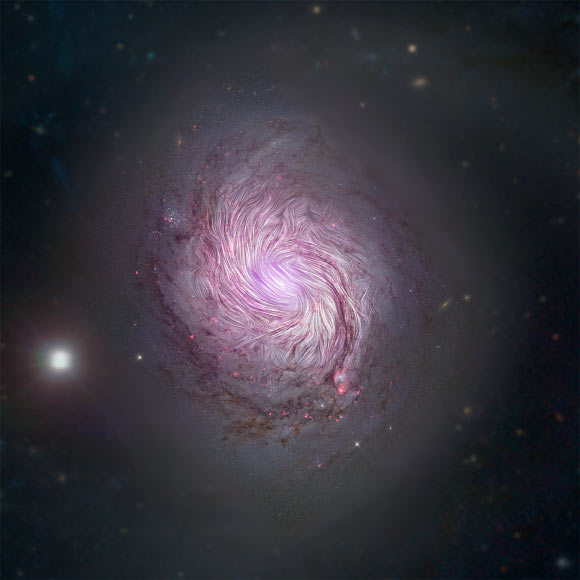Magnetic Fields Play Important Role in Shaping Spiral Galaxies | Astronomy – Sci-News.com
New infrared observations from NASA’s Stratospheric Observatory for Infrared Astronomy (SOFIA) of Messier 77, a spiral galaxy located 47 million light-years away in the constellation Cetus, have shed light on how spiral-shaped galaxies get their iconic shape.

Magnetic fields in the spiral galaxy Messier 77, also known as M77 and NGC 1086, are shown as streamlines over a visible light and X-ray composite image of the galaxy from the NASA/ESA Hubble Space Telescope, NASA’s Nuclear Spectroscopic Telescope Array (NuSTAR), and the Sloan Digital Sky Survey. The magnetic fields align along the entire length of the massive spiral arms of Messier 77, implying that the gravitational forces that created the galaxy’s shape are also compressing the its magnetic field. This supports the leading theory of how the spiral arms are forced into their iconic shape known as ‘density wave theory.’ SOFIA studied the galaxy using far-infrared light (89 microns) to reveal facets of its magnetic fields that previous observations using visible and radio telescopes could not detect. Image credit: NASA / SOFIA / JPL-Caltech / Roma Tre University.
“Magnetic fields are invisible, but they may influence the evolution of a galaxy,” said Dr. Enrique Lopez-Rodriguez, a Universities Space Research Association scientist at the SOFIA Science Center at NASA’s Ames Research Center.
“We have a pretty good understanding of how gravity affects galactic structures, but we’re just starting to learn the role magnetic fields play.”
Using SOFIA’s newest instrument, the High-resolution Airborne Wideband Camera-Plus (HAWC+), Dr. Lopez-Rodriguez and colleagues measured magnetic fields along Messier 77’s spiral arms, which are filled with dust, gas and areas of intense star formation called starbursts.
The observations revealed magnetic fields that closely follow the newborn-star-filled spiral arms.
This supports the leading theory of how these arms are forced into their iconic shape known as ‘density wave theory.’ The theory states that dust, gas and stars in the arms are not fixed in place like blades on a fan. Instead, the material moves along the arms as gravity compresses it, like items on a conveyor belt.
The magnetic field alignment stretches across the entire length of Messier 77’s arms — approximately 24,000 light years across.
This implies that the gravitational forces that created the galaxy’s spiral shape are also compressing its magnetic field, supporting the density wave theory.
“This is the first time we’ve seen magnetic fields aligned at such large scales with current star birth in the spiral arms,” Dr. Lopez-Rodriquez said.
“It’s always exciting to have observational evidence that supports theories.”
The study will be published in the Astrophysical Journal.
_____
E. Lopez-Rodriguez et al. 2019. SOFIA/HAWC+ traces the magnetic fields in NGC 1068. ApJ, in press; arXiv: 1907.06648





